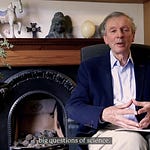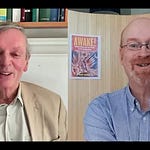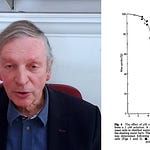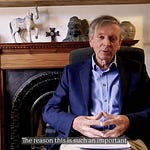Introduction: An extract from one of the last trialogues between Terence McKenna, Ralph Abraham and myself. This three-way dialogue took place at the University of California, Santa Cruz, in 1998, two years before Terence’s untimely death. Sadly, Ralph died last year. We first met in 1982 and so enjoyed talking with each other that we spent several days doing so every year from 1982 to 1998. Our first public trialogues were at the Esalen Institute in Big Sur, California in 1989, and after that many of our discussions were recorded. There are 57 of them in audio format on my website. We also published two books based on our discussions: Chaos, Creativity and Cosmic Consciosuness and The Evolutionary Mind.
Edited Transcript (not a verbatim transcript):
RUPERT: A speculation about our evolutionary past which I found particularly interesting is in Barbara Ehrenreich's book Blood Rites. She's an American writer based in New York. This book completely changed my ideas about human pre-history.
Ehrenreich shows very convincingly is that our image of Man the Hunter striding forth onto the African savanna about 3 million years ago, is in fact pretty implausible. Human beings were small. They couldn't run very fast. They weren't particularly strong. Their tools were extremely primitive. It's much more likely that for most of human history, it was not Man the Hunter, but people the hunted.
In fact, many bone remains of early hominids show the marks, scratches and tooth marks of large cats on them. Human beings lived on the African savanna with lots of game, but also with lots of big predators. They were extremely vulnerable and a great deal of modern human mentality, she argues, was shaped by millions of years of being preyed on by large predators.
It wasn't until about 50,000 years ago that there was an improvement in hunting technologies all around the world whereby human beings could indeed become effective hunters. But for most of the 3.5 million years of hominid history, it was people the hunted. She argues that this sheds light on religious traditions, because in many religions there's the key idea of the sacrificial victim.
When predators approach a herd of wildebeest or group of baboons, they usually attack isolated members of the group, the old, the young, the sick, or sometimes the young males who are defending the group on the periphery. Those are the ones that get killed first. And when they've killed one of them, they start eating it. Very often the rest of the group then relax, and they sometimes stand around and watch the predators eating their prey, because once they've got one victim, they are not hungry any more. They're not interested in the rest of the group. One dies for the sake of the others. This is a simple fact of predation.
Ehrenreich argues that this pattern, the idea of a sacrificial victim that dies and saves the rest, is deeply embedded in our consciousness. It's an archetypal pattern based on the biological fact of predation and the fact that we were preyed upon. She also shows that many early versions of gods and goddesses were in the form of carnivores. Even Jehovah is a carnivore, as in the story of Cain and Abel, where Cain is a farmer and offers the fruit of the earth to God as a sacrifice, and Abel is a herder and offers a sheep. Blood sacrifices continued in Judaism until the destruction of the temple in Jerusalem in 70 AD. God preferred the sacrifice of Abel; he chose meat over a vegetarian diet and that's why Cain killed Abel. He was jealous. The gods were also associated with predatory animals. For example, to this day the Indian goddess Durga is often pictured riding on her 'vehicle', a lion. And nations identify with predators as a kind of justification for war making, where the whole nation becomes like a predator. The symbol of England, Armenia, Ethiopia and many other countries is a lion; of the United States, Egypt and Germany, an Eagle; of India, Bangladesh and Malaysia a tiger. All around the world predatory animals serve as national emblems. Ehrenreich shows that because of this long history, much of our mythology, religious symbols and fears are related to being preyed on.
The nightmares of young children in modern cities like New York are often about being eaten by monsters and wild animals. They are not about the realistic kinds of fears that their parents might have: child molesters, infectious diseases and being run over by cars. Most children's nightmares reflect a long period of prehistorical predation by wild animals. One of the attractions of dinosaurs for children is that they are big and scary but safely extinct.
I think of these fears as part of our collective memory through morphic resonance. Jung called them archetypes in the collective unconscious. These memories have shaped our unconscious minds today, but we are largely unaware of these archaic aspects of our nature, because our normal study of history begins with the civilizations of Mesopotamia, Egypt, Greece and Rome, and leaves out the previous 3.5 million years of human history.
TERENCE: In my trying to understand this moment of transition 50,000 years ago or this moment of breakthrough, what exactly were the elements and how did it happen?
I've come very close to this area that Rupert's indicating because I can't help but notice that a successful predator must think like prey, that there is this peculiar intellectual symbiosis that goes on between the predator and the prey. Hunting cats and top carnivores, I think, internalize the behaviours of their prey.
At the very dawn of the emergence of the evolutionary emergence of mind, the central human figure in that equation is the shaman. And the shaman at the High Paleolithic stage is essentially a kind of sanctioned psychotic, in other words, able to move into states of mind so extreme that there immediate social efficacy is arguable. To condense that into common English, what I mean is the shaman is a person, a designated member of the social group, who can mentally change into an animal. Other members of the social group are appalled and draw back. And so, in a weird way, at this fractal boundary where human consciousness emerges, the first human consciousness was not human at all. It was a human ability to model effectively the thinking processes of other predators.
When we're talking about hunting is we're talking about strategic thinking. And strategic thinking always involves bifurcating trees of choice. If we go to the waterhole at dawn, perhaps we can make a kill. If we take food and leave the women and children and go in this direction for several days, perhaps we will make a kill. Perhaps not. Perhaps by abandoning the women and the children, we will undercut our gene pool and return to catastrophe. Strategic thinking. What strategic thinking requires is the ability to contemplate possibilities not immediately present. In other words, there's a kind of time binding function here. So I'm really not so much posing a question to Rupert as adumbrating what he said. I think this is where it all comes together in this very complicated relationship between fear, expectation, strategizing and the imagination. The two areas where I'm sure we could spend a great deal of time studying these bifurcating trees of possibility are in the food gathering and hunting domain, and then in the sexual domain, which today we call erotic fantasy. But in the High Paleolithic, erotic fantasy was rather closely welded to where your genes went and how your biological, propagation process proceeded. So the key, whether you believe it was through the stimulation of psilocybin or through the aping of the behaviour of other top predators that we aspired to compete with, the domain in which the change was born and in which we will live until we leave the body behind us, is the domain of the imagination.
This is what we created that is uniquely human, and that has defined us ever since. And as this discussion today proceeds to look more into the future, I think we will see that as the imagination has been our past and the cradle of our humanness, so it also is the domain in which our trans human metamorphosis will occur.
RALPH: But why? This need for strategic thinking was not only was a constant throughout the 3.5 million years evolution of hominids, but also in pathogens, apes, swarming bees, schooling fish and so on.
Thre is more or less no news here. What was it then that happened 50,000 years ago if anything happened?
Alexander Marshak led a combined group of two scientific species, neurophysiologists and archaeologists, to proposed the miracle that occurred 50,000 years ago had to do with a structural change in neurophysiology. This presents the view, if you want to look at it that way, of God as a brain surgeon. The changes in the skull, the morphological changes at that time including the enlargement of the frontal lobes, which was considered to be the physiological foundation for the development of speech.
Broca's brain evolved because, as we had already started speaking and had the need for more vocabulary in terms of hunting, gathering, escaping large carnivores, and so on.
Anyway, there's a dichotomy of two different views about this bifurcation about 50,000 years ago: divine intervention and the random-mutation and natural-selection one. Isn't that it? And in this dichotomy, Rupert and Terence, you seem opposed, because Terence believes that the eating of psilocybin mushrooms is a purely material explanation, that requires no recourse to a divine intervention in the field.
TERENCE: Rupert isn't suggesting a literal divine intervention. He's just speaking metaphorically.
RUPERT: I'm speaking literally, because I think one of the things we have to explain is that religion, or some sense that there is something beyond the human realm of consciousness, is found in every human culture today, in some way or another. There is a world of spirits, a world of angels, of gods. To explain the universal distribution of this as part of traditional human thinking requires at some stage in the past there to have been to an awareness of this other realm of consciousness. Now, this is not incompatible with psilocybin or any other drug hypothesis, because those might have kick-started this connection with another realm of consciousness. But if we assume that today all over the world, shamanic cultures and all other cultures have the sense of other levels and other kinds of conscious entities beyond the human level, some in animal forms and some in forms way beyond that, we have to assume that at some stage in the past, there was a linking with these other realms of consciousness, whatever they are. Not just metaphors, not just archetypes in the collective mind, but forms of consciousness that might well be, and I think actually are, out there.











